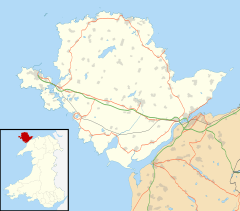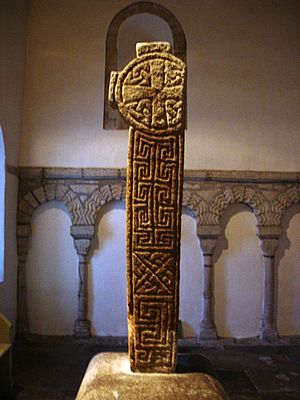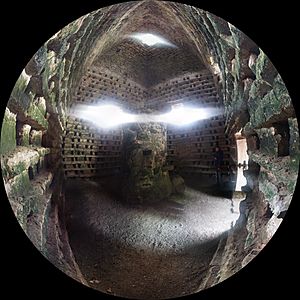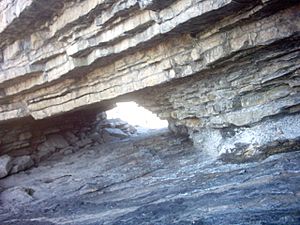Penmon facts for kids
Quick facts for kids Penmon |
|
|---|---|
| Population | < 1,275 |
| OS grid reference | SH623802 |
| Community |
|
| Principal area | |
| Ceremonial county | |
| Country | Wales |
| Sovereign state | United Kingdom |
| Post town | BEAUMARIS |
| Postcode district | LL58 |
| Dialling code | 01248 |
| Police | North Wales |
| Fire | North Wales |
| Ambulance | Welsh |
| EU Parliament | Wales |
| UK Parliament |
|
| Welsh Assembly |
|
Penmon is a small village and a piece of land that sticks out into the sea, located on the eastern tip of Anglesey in Wales. It's about 3 miles (4.8 km) east of the town of Beaumaris. The name Penmon comes from the Welsh words pen, meaning "head" or "promontory", and Môn, which is the Welsh name for Anglesey.
Penmon is famous for its old monastery and a church built in the 12th century. Some walls near a well by the church might even be part of the oldest Christian building still standing in Wales! Penmon also has a great beach and is part of the Anglesey Coastal Path. Stone from Penmon's quarries was used to build important places like Birmingham Town Hall and the two big bridges over the Menai Strait. Both locals and visitors love Penmon for its history, quiet atmosphere, fresh air, and amazing views of Snowdonia.
Contents
Penmon's Past: A Look at History
Long ago, in the early 6th century, a monastery (a place where monks live) was started in Penmon. It was founded by Saint Seiriol on land given by his brother, Saint Einion, who was a king. Even though Seiriol later moved to a quiet place on nearby Puffin Island, the monastery grew. Two crosses were placed at its entrance.
In 971, Vikings attacked and destroyed much of Penmon. But the two crosses and a fancy font from that time still exist today. In the 12th century, the church was rebuilt with stone. Later, in the 13th century, Penmon became an Augustinian priory, which is a type of monastery with a more organised way of life.
The priory kept going even after King Edward I conquered Wales. However, it was eventually closed down in 1538 during the time of the Dissolution of the Monasteries. The buildings then went to the Bulkeley family, a powerful local family from Beaumaris. They still own and use some of the buildings today. The Bulkeleys also turned most of the land into a deer park and built the dovecot near the church.
Weather in Penmon
The weather in Penmon is generally milder and drier than many other parts of Wales. Here's a quick look at the average temperatures and rainfall:
| Month | Jan | Feb | Mar | Apr | May | Jun | Jul | Aug | Sep | Oct | Nov | Dec | Year |
|---|---|---|---|---|---|---|---|---|---|---|---|---|---|
| Average max. temperature °C |
8.2 | 8.2 | 9.9 | 11.5 | 14.8 | 17.0 | 19.3 | 19.2 | 17.0 | 14.1 | 10.8 | 9.1 | 13.3 |
| Average min. temperature °C |
2.8 | 2.6 | 3.9 | 5.0 | 7.3 | 10.0 | 12.1 | 12.1 | 10.2 | 7.9 | 5.3 | 3.7 | 6.9 |
| Rainfall mm |
76.8 | 48.0 | 58.2 | 46.5 | 54.3 | 58.6 | 43.9 | 63.4 | 66.9 | 90.9 | 88.9 | 91.6 | 788.1 |
| Source: Met Office | |||||||||||||
People of Penmon
In 1775, a book about Anglesey mentioned that Penmon had lots of large oysters. Poor people found work collecting and preparing the fish for sale to other countries.
In 1801, Penmon had 169 people. By 1831, most adults worked in farming or as servants. The number of people living in Penmon changed over time, reaching 291 in 1821, then dropping to 213 in 1871, and rising to 300 by 1931.
The 2001 census showed that the area around Penmon had 1,275 people. About 60% of them were born in Wales, and 36% were born in England. Around 63% of the people could speak some Welsh language.
Interesting Places to Visit
Penmon has some really cool old buildings and a nearby island, all with fascinating stories. These buildings, like the Priory and church, the dovecot, and the well, are all close together where the old monastery used to be.
Penmon Priory: A Historic Monastery
The monastery, also known as St Seiriol's monastery, grew over time. By the 10th century, it had a wooden church. This wooden church was destroyed in 971 and then rebuilt with stone between 1120 and 1123. The oldest parts of the Priory Church of St Seiriol date back to 1140.
The church was made bigger in the early 13th century. Records show that leaders called Priors were elected there as far back as 1306. The monks used to eat in a dining hall on the first floor, with storage below and sleeping areas above. Later, a kitchen was added.
Llywelyn Fawr, a Welsh prince, and the rulers after him made the church very rich by giving it land. This land was taken away when the monasteries were closed in 1536, but the church itself survived.
Today, St Seiriol's Church is part of the church community of Beaumaris. It has received money to help repair its roof and walls, keeping this important historic building safe. The priory and its dining hall are special buildings, protected as Grade I listed buildings, and the whole priory area is a Scheduled monument.
Ancient Crosses of Penmon
The two old crosses from the 10th century that once stood outside the monastery are now kept inside the church. One cross is larger but has been damaged by weather because it was outside until 1977. The other cross is smaller and in better condition, but one of its arms was cut off long ago because it was used as a stone support for a window!
St Seiriol's Well: A Healing Spring
Like many old Celtic churches, Penmon's church was built near a well. The monks of Penmon built this well, and some people believed it had healing powers. It's thought to be one of the oldest buildings in Penmon. Some say the lower stone walls near the well were part of Seiriol's church from the 6th century, which would make it the oldest Christian building still standing in Wales.
Water from this well has been used as a symbol of Anglesey at big events like the International Island Games. The well and its small chamber are also protected as a Grade I listed structure and a Scheduled monument.
The Penmon Dovecot
The dovecot near the church was probably built around 1600, during the time of Queen Elizabeth I. Sir Richard Bulkeley built it to keep pigeons for their eggs and meat. It has a large round roof with a small dome on top, so the birds could fly in and out. Inside, there were 1,000 nesting boxes! A central pillar once held a spinning ladder that allowed people to reach all the nesting boxes. The pillar is still there, but the ladder is gone. The dovecot is a special building, protected as a Grade II* listed structure and a Scheduled monument.
Puffin Island: A Wildlife Haven
Saint Seiriol also started a small community on Puffin Island (called Ynys Seiriol in Welsh), which is half a mile from the coast. There's still a tower from a 12th-century church on the island. It's believed that St Seiriol and perhaps Maelgwn Gwynedd, a king from the 6th century, were buried there.
The island used to have many puffins and guillemots. Sadly, rats caused the bird population to drop a lot in the 1890s.
In 1748, a man named Lewis Morris suggested turning the ruined church tower into a lighthouse, but this didn't happen. However, after a terrible ship accident in 1831 where many lives were lost, the Trwyn Du Lighthouse and a lifeboat station were built to help prevent future tragedies. The lifeboat station closed in 1915, but during its time, the Penmon lifeboats saved at least 143 lives.
Penmon Beach: A Seaside Award Winner
Penmon beach is a great place to visit! It won a "Seaside Award" in 2006 from the "Keep Wales Tidy" group. To get this award, beaches must have clean water, be safe, and be well-managed. Penmon is a "rural" beach, meaning it's more natural and doesn't need lots of facilities like toilets or big car parks to win the award. It has received this award every year since 2003.
Penmon's Rocks and Quarries
Penmon has interesting geological features, including fossils and a tunnel under a cliff. The cliff is made of layers of limestone and shale. These rock layers have been moved many times by faults, which are cracks in the Earth's crust. The cliff is about eight metres high.
The grey-brown limestone found in Penmon is known as "Penmon marble." You can sometimes find brachiopod fossils in it. The biggest quarry, Dinmor Park, was used to get limestone from about 1898 until the 1970s. Penmon limestone was used to build important places like Birmingham Town Hall and to help rebuild Liverpool and Manchester after World War II. This stone was also used to build the famous Menai Suspension Bridge (finished in 1826) and the Britannia Bridge (finished in 1850).








